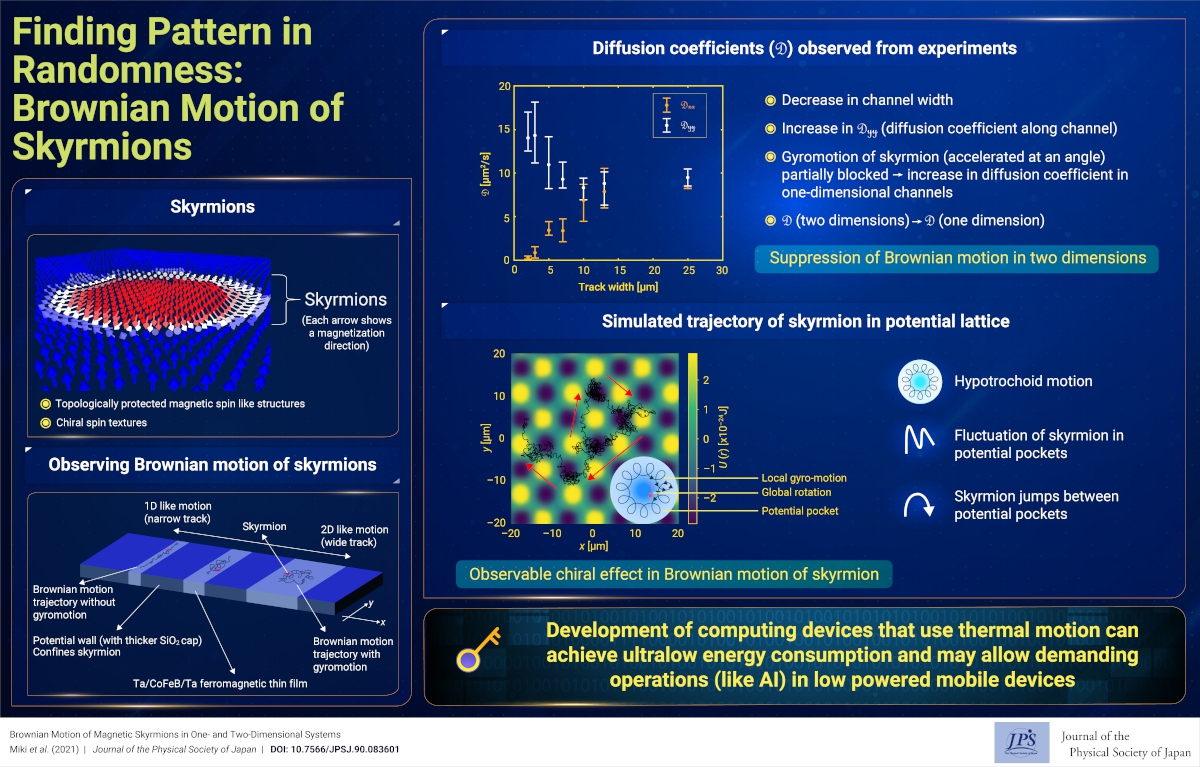Finding Pattern in Randomness: Brownian Motion of Skyrmions
© The Physical Society of Japan
This article is on
Brownian Motion of Magnetic Skyrmions in One- and Two-Dimensional Systems
(JPSJ Editors' Choice)
J. Phys. Soc. Jpn.
90,
083601
(2021)
.
The chiral properties of the Brownian motion of magnetic skyrmions in one- and two-dimensional systems in thermal equilibrium are reported.

Magnetic skyrmions exhibit unique dynamical properties. However, it is unclear whether the Brownian motion of skyrmions exhibits chiral properties in thermal equilibrium derived from the Magnus force. For example, when a skyrmion is driven by an electric current, the driving force is parallel to the current. However, its trajectory is bent by the Magnus force, which is proportional to the skyrmion number. Consequently, the skyrmion Hall effect is observed. Such chiral motion of skyrmions has been observed in the presence of a driving force. However, whether the Brownian motion of skyrmions exhibits chiral properties in thermal equilibrium remains unclear. (Note that the chiral property in this study is not that of skyrmions but of their motion.) In this study, we show that chiral properties play an essential role in the diffusion of skyrmions by performing the following two experiments:
Diffusion of skyrmions in one-dimensional and two-dimensional channels
The diffusion coefficient of skyrmions in one-dimensional narrow channels is a factor of 1.3–1.9 larger than that in two-dimensional films. This is because the confinement of skyrmions in one-dimensional channels suppresses their gyration.
Observation of angular momentum of diffusion in two-dimensional systems
We evaluated chiral properties by analyzing the diffusion of skyrmions using the spontaneous velocity–position correlation functions, i.e., <v(t)・x(t)> and <(v(t) × x(t))z> [1], and obtained the finite value of <(v(t)×x(t))z> as a thermal average. This result indicates the existence of the off-diagonal term of the diffusion coefficient of the skyrmions' motion. In addition, the sign of the observed <(v(t)×x(t))z> is opposite to the sign of the simple theoretical prediction, i.e., the direction of rotation is opposite to that predicted by theory. This can be explained by considering the shallow potential fluctuation in the films. The orbit of skyrmions captured by the harmonic potential was a hypotrochoid, a combination of two circular motions, with thermal fluctuation. The small, high-frequency circular motion was the intrinsic gyration of skyrmions. In contrast, a low-frequency orbit that rotated along the edge of the potential exhibited reverse rotation. Because the camera's frame rate was set at 30 ms−1 in the experiments, only the global rotation in the direction opposite to that of the local gyration was observed. The observation of the intrinsic gyration and mass of skyrmions under Brownian motion should be examined in the future [2].
(Written by S. Miki on behalf of all authors)
References
[1] Y. Suzuki, S. Miki, Y. Imai, and E. Tamura, Phys. Lett. A, 413, 127603 (2021), and references therein.
[2] I. Makhfudz, B. Krüger, and O. Tchernyshyov, Phys. Rev. Lett. 109, 217201 (2012).
Brownian Motion of Magnetic Skyrmions in One- and Two-Dimensional Systems
(JPSJ Editors' Choice)
J. Phys. Soc. Jpn.
90,
083601
(2021)
.
Share this topic
Fields
Related Articles
-
Qualitative Changes in Kinetic Pathways Driven by Hydrodynamic Interactions in Dense Colloidal Suspensions
Cross-disciplinary physics and related areas of science and technology
Statistical physics and thermodynamics
Structure and mechanical and thermal properties in condensed matter
2025-4-18
Even in dense colloidal suspensions, where long-range hydrodynamic interactions are screened, near-field hydrodynamic interactions qualitatively influence the selection of kinetic pathways.
-
Higher-Order Topological Phases in Magnetic Materials with Breathing Pyrochlore Structures
Electronic structure and electrical properties of surfaces and nanostructures
Magnetic properties in condensed matter
Mathematical methods, classical and quantum physics, relativity, gravitation, numerical simulation, computational modeling
2025-4-7
A simple example of a higher-order topological phase, in which the symmetry decreases step-by-step from the bulk to the corner, is realized in a magnetic system with a pyrochlore structure and is characterized by a series of quantized Berry phases defined for the bulk, surface, and edge.
-
Existence of Chiral Soliton Lattices (CSLs) in Chiral Helimagnet Yb(Ni1-xCux)3Al9
Magnetic properties in condensed matter
2025-4-1
Our study examines the magnetic structure of the monoaxial chiral helimagnet Yb(Ni1-xCux)3Al9, providing first direct evidence of the formation of chiral soliton lattice state.
-
Understanding Pressure-Induced Superconductivity in CrAs and MnP
Magnetic properties in condensed matter
2025-3-10
This study reviews existing research on the pressure-induced variation of magnetic properties of transition metal mono-pnictides like CrAS, MnP, and others, aiming to understand the unconventional superconductivity observed in CrAs and MnP.
-
A Unified Theory of Topological Hall Effect
Electronic transport in condensed matter
2025-3-6
This paper presents a unified theoretical description for the topological Hall effect, covering the entire region from strong- to weak-coupling, extending its picture beyond the Berry phase.




